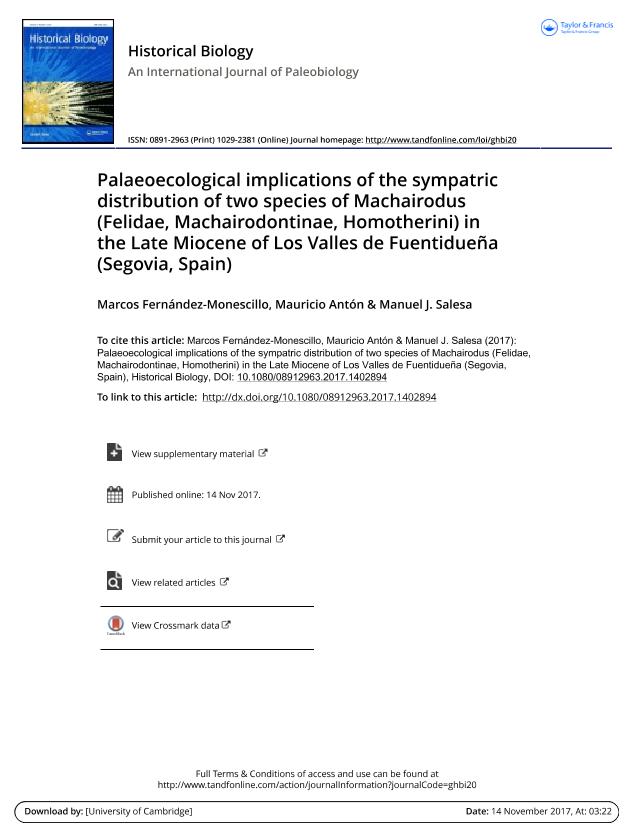Artículo
Palaeoecological implications of the sympatric distribution of two species of Machairodus (Felidae, Machairodontinae, Homotherini) in the Late Miocene of Los Valles de Fuentidueña (Segovia, Spain)
Fecha de publicación:
11/2017
Editorial:
Taylor & Francis
Revista:
Historical Biology
ISSN:
0891-2963
e-ISSN:
1029-2381
Idioma:
Inglés
Tipo de recurso:
Artículo publicado
Clasificación temática:
Resumen
In this paper, we study a sample of cranial, mandibular and dental remains of two species of the machairodontine felid genus Machairodus from the Early Vallesian (MN 9, around 10 Ma) site of Los Valles de Fuentidueña (Segovia, Spain): the tiger-sized Machairodus aphanistus, and the smaller and more primitive M. alberdiae; a species which is only known from this site. The fossils of these two sympatric populations are compared with the most abundant samples of M. aphanistus from the Late Vallesian (MN 10), younger sites of Batallones-1 and Batallones-3 (Torrejón de Velasco, Madrid, Spain). The results support the specific separation of M. alberdiae from M. aphanistus based on several differences in teeth size and proportions. Besides this, we observed differences among the analysed samples of M. aphanistus, indicating a differentiation between the older and more primitive form from Los Valles de Fuentidueña, and the younger and more derived one from the two Batallones sites. These differences fit well with the morphological evolution of this lineage towards the more derived Turolian Amphimachairodus giganteus. Finally, a relatively structured, patched habitat, combining the presence of open landscapes with shrubby and wooded areas, is inferred to explain the sympatric distribution of these two large machairodontines in Los Valles de Fuentidueña.
Palabras clave:
Felidae
,
Machairodontinae
,
Machairodus
,
Miocene
,
Spain
,
Vallesian
Archivos asociados
Licencia
Identificadores
Colecciones
Articulos(IANIGLA)
Articulos de INST. ARG. DE NIVOLOGIA, GLACIOLOGIA Y CS. AMBIENT
Articulos de INST. ARG. DE NIVOLOGIA, GLACIOLOGIA Y CS. AMBIENT
Citación
Fernández García, Marcos; Antón, Mauricio; Salesa, Manuel J.; Palaeoecological implications of the sympatric distribution of two species of Machairodus (Felidae, Machairodontinae, Homotherini) in the Late Miocene of Los Valles de Fuentidueña (Segovia, Spain); Taylor & Francis; Historical Biology; 2017; 11-2017; 1-11
Compartir
Altmétricas




